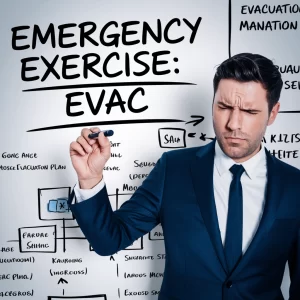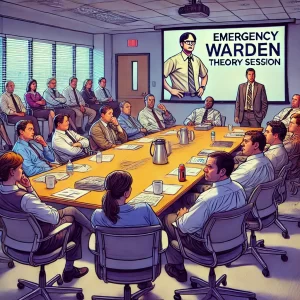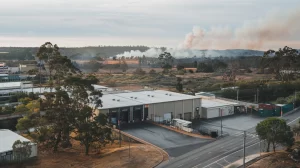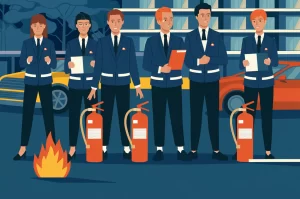Emergencies rarely come with a warning, and when they strike, the way your workplace responds could be the difference between chaos and safety. That’s why an Emergency Control Organisation (ECO) is a must-have for any business or institution. The ECO is a structured team, usually composed of key personnel who know exactly what needs to be done in an emergency.
In this article, we’ll walk through the main roles within an ECO and break down what each team member should be doing before, during, and after an emergency. This is more than just knowing where the fire exits are – it’s about creating a culture of readiness that can handle anything from fire evacuations to medical emergencies. Whether you’re leading the charge as a Chief Warden or making sure your area is clear as an Area Warden, we’ve got practical tips to help you get the job done.
1. Chief Warden Responsibilities: Leading from the Front
The Chief Warden is the ultimate leader of the Emergency Control Organisation. They’re responsible for making sure the entire emergency response plan is in place and effective. In many ways, the success of the ECO hinges on the Chief Warden’s preparedness and decision-making skills during an emergency.
Before an Emergency:
- Develop and maintain the emergency response plan: The Chief Warden’s primary job is ensuring that the emergency plan is tailored to the workplace’s unique layout, risks, and number of staff. This plan should include everything from evacuation routes to roles and responsibilities of every ECO member.
- Ensure all ECO members are trained: It’s not enough to have a plan – you need people who know how to execute it. The Chief Warden oversees regular training and ensures every ECO member is confident in their role.
- Conduct regular emergency drills: Fire drills aren’t just for show. Drills allow your team to practice under simulated conditions, helping everyone feel more prepared if the real thing ever happens.
- Identify potential hazards: A Chief Warden needs to be aware of any hazards in the workplace that could turn a minor emergency into a major disaster, like blocked exits or faulty equipment.
During an Emergency:
- Initiate the emergency response plan: As soon as an emergency is identified, the Chief Warden takes charge by activating the plan. This includes informing all personnel and giving clear instructions on what to do next.
- Coordinate with emergency services: The Chief Warden is the key point of contact for emergency services, making sure they have the information they need to do their job effectively.
- Manage communication: A big part of the Chief Warden’s role is keeping lines of communication open between the ECO members, staff, and emergency services. This helps avoid confusion and ensures everyone knows their role.
- Ensure orderly evacuations or shelter-in-place: Whether it’s guiding people to safety during a fire or managing a lockdown, the Chief Warden makes sure that everyone follows procedures calmly and efficiently.
After an Emergency:
- Debrief with ECO members: Once the dust has settled, the Chief Warden needs to meet with the ECO team to review what went well and what didn’t.
- Document lessons learned: Any emergency is a learning experience. The Chief Warden is responsible for updating the emergency plan based on feedback from the incident.
- Update the emergency plan: If there were any gaps in the response, they need to be fixed. The Chief Warden leads the charge in making sure the plan stays relevant and up-to-date.
2. Area Warden Responsibilities: Keeping Your Zone Safe
As an Area Warden, you’re responsible for a specific part of the workplace. Your job is to make sure everyone in your area knows what to do in an emergency and to guide them safely out or to a safe location.
Before an Emergency:
- Understand emergency exits and equipment locations: Every Area Warden should be intimately familiar with evacuation routes, fire extinguishers, and first aid kits in their zone.
- Conduct regular checks of your assigned area: Periodically walking through your area to make sure there are no blocked exits, faulty equipment, or other hazards is crucial.
- Ensure staff are familiar with evacuation routes: In addition to your own preparedness, make sure the people in your area know the quickest and safest way out.
During an Emergency:
- Direct staff to the nearest safe exit: In an evacuation, Area Wardens help keep things calm and direct people to the safest, nearest exit.
- Perform a sweep of the area: Before you evacuate, it’s your job to make sure no one’s left behind – especially in bathrooms or closed-off areas.
- Assist individuals with mobility issues: Not everyone can evacuate quickly, and part of the Area Warden’s role is making sure these individuals get the help they need.
After an Emergency:
- Report any damage or safety hazards: Once the emergency is over, take note of any damage in your area that might pose future risks.
- Participate in the debriefing session: Your feedback is important. You’ll be involved in reviewing the event to improve future responses.
3. Communication Officer: Keeping Everyone Informed
In an emergency, communication is everything. The Communication Officer plays a crucial role in making sure everyone – from the Chief Warden to the rest of the ECO – stays on the same page.
Before an Emergency:
- Ensure all communication devices are functional: Radios, phones, and intercom systems need to work when it matters most.
- Practice using communication systems: You don’t want to be figuring out how the system works during an emergency. Make sure you’re comfortable using it beforehand.
During an Emergency:
- Relay updates from the Chief Warden: The Communication Officer ensures that all team members are aware of updates and next steps.
- Maintain communication with emergency services: Keeping in touch with fire, police, or medical teams is critical to a coordinated response.
- Notify external stakeholders: If the situation calls for it, the Communication Officer may also need to keep external parties in the loop.
After an Emergency:
- Provide updates to staff: Communication doesn’t end once the emergency does. The Communication Officer plays a role in keeping everyone updated on the next steps.
- Assist in documenting the event: Your records will be key to analyzing how communication flowed during the emergency and what can be improved.
4. First Aid Officer: Immediate Response to Injuries
The First Aid Officer is the go-to person for medical emergencies. When injuries happen, their immediate response can be life-saving.
Before an Emergency:
- Check first aid kits and medical supplies: This should be done regularly to make sure all necessary supplies are in stock.
- Attend training: First Aid Officers need to keep their certifications up to date.
During an Emergency:
- Provide first aid: Whether it’s a minor injury or a life-threatening condition, the First Aid Officer takes charge of medical care.
- Coordinate with medical services: If more advanced care is needed, the First Aid Officer works with external medical teams.
After an Emergency:
- Review the medical response: After an emergency, evaluate how well the first aid response went and look for areas of improvement.
- Replenish supplies: Make sure any used supplies are restocked and ready for the next event.
5. Post-Emergency Recovery: What Happens Next?
Even after the immediate danger has passed, the ECO’s work isn’t over. Post-emergency recovery ensures that the workplace is ready for the next potential event and that any lessons learned are applied.
- Review and Revise Plans: Every emergency is an opportunity to learn. After each incident, review the entire response plan and make necessary adjustments.
- Training and Drills: Continuous practice through drills is key to keeping everyone sharp.
- Communication with Staff: It’s important to keep all staff updated on new procedures and reinforce the importance of safety protocols.
Conclusion:
The Emergency Control Organisation plays a vital role in ensuring workplace safety during an emergency. Each role, from the Chief Warden to the First Aid Officer, has a set of clear responsibilities that must be carried out before, during, and after an emergency. By taking their roles seriously and preparing well in advance, the ECO can help ensure that any emergency situation is handled smoothly and efficiently. If you’re part of an ECO, now’s the time to review your procedures and make sure your team is ready for any situation that comes your way.






